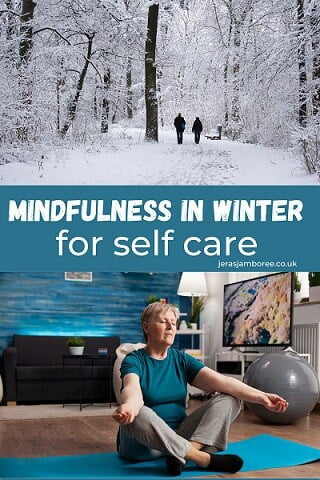The cold, grey days and long, dreary nights of winter are an ideal time to establish a mindfulness practice.
Mindfulness is helpful in dealing with stress and other challenges such as anxiety and depression, and it is an effective self care tool that can easily be applied by anyone, anywhere.
There are mindfulness practices that can be incorporated into daily life that can help to bring a sense of calm and peace to both our inner and outer beings, no matter the weather.

Some practical ways to practice mindfulness in the winter include:
Sitting Meditation
Perhaps the most well-known mindfulness technique, sitting meditation essentially involves quieting your mind and recognising your emotions.
By doing this, we can honour our feelings while at the same time learn not to be controlled by them.
By bringing stillness to our minds, we can stay in the present moment.
We allow ourselves to pause and to relax, to restore harmony and balance to our lives.
There are many methods of sitting meditation to choose from.
The most basic technique is to find a quiet place to sit, close your eyes, and focus on your breath.

Thoughts will race through your mind, and that is perfectly normal and acceptable.
When this happens, simply return to focusing on breathing in and breathing out.
Do this as many times as you need to in a non-judgmental way.
I find that a guided meditation to start my day helps me to present throughout the day.
You might find the Guided Mindfulness Sitting Meditation by Jon Kabat Zinn helpful. Jon Kabat Zinn is the master of mindfulness.
Although it can be difficult to find time to meditate in our hectic lives, even taking five or ten minutes in the morning or evening can prove to be very valuable.
Mindfulness Breathing
Many people find that a mindfulness practice that involves intentional breathing does wonders.
The act of breathing in and breathing out at a controlled pace helps to regulate our heart rhythms and keeps us from hyperventilating, which can be miraculous in extremely stressful situations.
Learning proper breathing techniques is an essential form of mindfulness self care.
One popular breathing technique is known as “4-7-8 Relaxing” breathing.
Inhale for a count of 4, hold your breath for a count of 7, and then exhale for a count of 8.
Repeating this intentional breathing exercise for a few cycles can bring rapid relief to an overburdened mind and body.
Explore Nature Mindfully
The shorter, darker days of winter can be difficult to endure.
Although it seems counterintuitive to venture outside into the cold, getting outside to explore and spend time in nature is one of the most healing gifts that we can give ourselves.
Being exposed to even a little sunlight, along with getting exercise, increases our feelings of contentment.

Walking through the woods or going to the park are incredible ways to explore nature in the winter.
We can incorporate mindfulness into our nature explorations by pausing to examine what we see while outside.
Notice the birds that are still around. Look at the shapes of the icicles hanging from the trees. Feel the wind on your face.
Take a moment to appreciate nature is an incredible form of mindfulness.
Practicing mindfulness is important for staying stress-free and calm during the winter.
Try these two simple mindfulness exercises this winter and you will notice the difference.